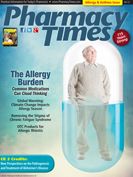Publication
Article
Pharmacy Times
Cold Watch
In Search of a Symptom-Free Cold
There are more than 150 rhinoviruses that account for half or more of the colds that people catch. Unfortunately, a symptom-free cold is the closest we will most likely get to a cure, according to David Proud, PhD, professor of physiology and pharmacology at the University of Calgary.
Dr. Proud is purposely infecting people with cold viruses at The University of Calgary—1 of only 2 places in North America approved to use human subjects in this manner—in an effort to examine how infected cells produce both host defense molecules, which may protect against viral infections and inflammation, and proinflammatory cytokines, which could worsen inflammation.
Dr. Proud and his colleagues sought to determine if the balance between these responses could help determine susceptibility to acute exacerbations of asthma, chronic obstructive pulmonary disease, cystic fibrosis, bronchitis, and emphysema. Researchers were specifically looking for substances the body makes when it tries to fight off colds to try to assess if these play a role in viral modulation of airway inflammation.
“What we’ve been working on is trying to understand which of these antiviral molecules are most important,” said Dr. Proud to CBC News. “[If] we can find a way to boost how you produce them or maybe supplement them with some sort of spray system, that would allow you to have a better immune response.”
East Coast Worse for Colds than West Coast
Data from a Gallup study tracking the cold and flu season starting from November 2011 may persuade some to move to the west to avoid catching more colds.
The Gallup-Healthways Well-Being Index asked 1000 Americans each day whether they had a cold or the flu “yesterday.” Based on the responses, researchers calculated that 9.6% of Americans in the East reported being sick with a cold a day before the survey started, which is significantly more than any other region. Interestingly, of those reporting they were sick with the flu “yesterday,” the West had the highest number of incidences at 2.7%, slightly above the 2.6% reported in the East. The reported daily cold and flu levels were nearly identical to the Gallup numbers reported last year.
The cold doesn’t get its “common” title for nothing. In general, the percentage of Americans who reported they had a cold on any given day is roughly 3 times greater than the percentage who reported they had the flu. The Gallup researchers note that this may be a limitation to their survey, as measuring a cold versus the flu can be difficult as a result of their shared symptoms.
For information pharmacists can share with their patients to help them differentiate between a cold or the flu, see “Influenza vs the Common Cold: Symptoms and Treatment.”
Know the Signs of Respiratory Syncytial Virus
Although respiratory syncytial virus (RSV) only causes mild cold symptoms in adults, it can be very serious for young children and adults with compromised immune systems. According to the Centers for Disease Control and Prevention, RSV is the most common virus that causes lung and airway infections in infants and young children, and most infants have had this infection by 2 years of age.
Dr. Rahul Bhatia, MD, of the pediatric intensive care unit at Loyola University Health System and assistant professor at Loyola University Chicago Stritch School of Medicine, notes that symptoms of RSV can vary somewhat from child to child. Children should be seen by a physician, however, if they exhibit any of the following symptoms:
- Increased breathing difficulties
- Nasal flaring
- Decreased appetite
- Decreased urine output
Children should be taken to the emergency department if they stop breathing, have serious problems breathing, or if their coloring becomes dusky.
“RSV is easily spread by touching infected people and surfaces, so washing your child’s and your own hands often is the best way to prevent it from being spread,” Dr. Bhatia told ScienceDaily. “This is an extremely contagious virus, so it can be easily spread from one child to another in a school or home setting.”
Fast Fact: According to the Centers for Disease Control and Prevention, the number of cases of respiratory syncytial virus tends to peak in the winter and decline by early spring.







